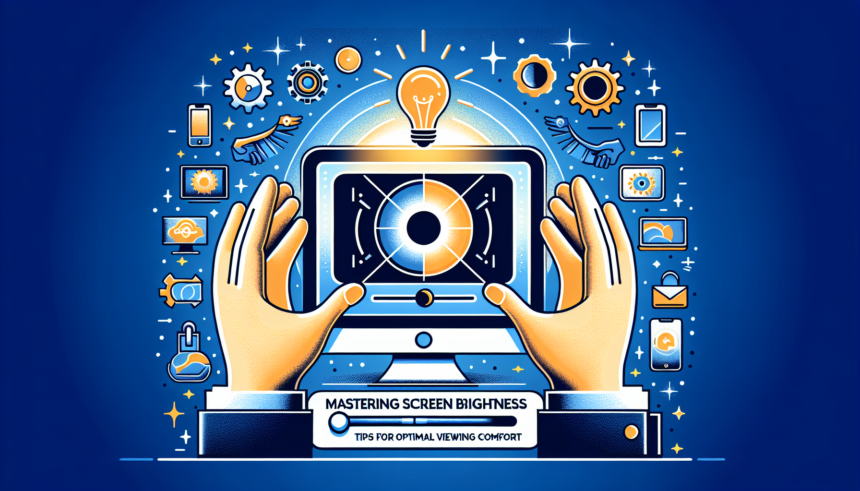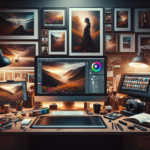In our technology-driven world, screens are ubiquitous. Whether it’s for work, education, or leisure, we spend countless hours in front of our monitors, smartphones, and tablets. However, prolonged exposure to screens can lead to eye strain, discomfort, and even longer-term issues if not managed properly. One crucial factor in ensuring a healthy visual experience is mastering the art of screen brightness adjustment. In this article, we delve into the importance of optimal screen brightness, provide actionable tips for finding the right balance, and answer some common questions about screen brightness and eye health.
Why Brightness Matters
Screen brightness is a key element affecting our eye health and overall comfort. Too bright or too dim screens can cause various issues:
- Eye Strain: High brightness can cause eye strain, particularly in dim environments.
- Sleep Disruption: Excessive brightness, especially during nighttime, can adversely impact sleep patterns by disrupting the production of melatonin.
- Battery Life: On portable devices, higher brightness settings can significantly drain battery life.
Finding the Right Brightness
Optimal screen brightness is not a one-size-fits-all setting. It depends on various factors including ambient lighting, screen type, and personal preferences. Here are some tips to help you find the right brightness level:
1. Match Screen Brightness to the Environment
A straightforward rule is to match your screen brightness to the surrounding environment. In well-lit settings like outdoors during the daytime, increase the brightness to counteract the natural light. Conversely, in low-light or dark settings, reduce your screen brightness to a comfortable level.
2. Adjust Based on Task
Different tasks require different brightness levels. Reading documents or browsing websites generally needs less brightness compared to tasks like photo editing or gaming, where higher brightness may enhance visibility of details.
3. Use Adaptive Brightness Features
Modern devices often come with adaptive or automatic brightness features that use sensors to adjust the screen brightness based on the surrounding light. While these can be highly useful, it’s important to occasionally tweak the settings manually to ensure comfort.
4. Apply Blue Light Filters
Blue light filters or night mode features can reduce the blue light emission from screens, which is known to cause eye strain and disrupt sleep patterns. Many devices offer built-in blue light filters that adjust the color temperature of the screen for more comfortable evening and nighttime use.
5. Regular Breaks and Eye Exercises
Even with optimal brightness settings, prolonged screen time can still strain your eyes. Practice the 20-20-20 rule; every 20 minutes, look at something 20 feet away for at least 20 seconds. This can help reduce eye fatigue and increase comfort.
Setting Up for Various Devices
Different devices have different methods for adjusting screen brightness. Here are some general guidelines for various types of screens:
1. Computer Monitors and Laptops
On computers and laptops, brightness settings can typically be adjusted through the system’s settings menu or function keys (Fn keys). Windows and MacOS platforms both have intuitive brightness controls accessible from the system taskbar or settings pane.
2. Smartphones and Tablets
For handheld devices, brightness can often be adjusted through the notification shade (for Android) or the Control Center (for iOS). Both operating systems also offer adaptive brightness settings and blue light filters such as ‘Night Shift’ on iOS and ‘Night Mode’ on Android.
3. Televisions and Streaming Devices
Televisions often require manual adjustment via either a settings menu or hardware buttons on the remote control. Many modern TVs come equipped with ambient light sensors that can automatically adjust brightness. Additionally, streaming devices may have their own settings for brightness adjustments, especially if they come with integrated screens.
Ergonomics and Screen Position
Optimal screen brightness is part of the equation, but ergonomics play a crucial role in reducing eye strain and promoting visual comfort. Consider the following ergonomic tips:
1. Position Your Screen Properly
The position of your screen significantly impacts visual comfort. Ideally, the top of the screen should be at or slightly below eye level to minimize neck strain. Ensure a comfortable viewing distance, typically at arm’s length, and adjust your chair and desk height accordingly.
2. Minimize Glare
Glare from overhead lighting, windows, or other reflective surfaces can strain your eyes. Position your screen to avoid direct reflections and use anti-glare screen protectors if necessary.
3. Adjust Color Temperature
Color temperature settings can also enhance visual comfort. Warmer color temperatures are generally easier on the eyes, especially in low-light environments. Many devices and monitors have settings to adjust color temperature or integrate third-party software solutions like f.lux.
Maintaining Eye Health
In addition to optimal brightness and ergonomics, maintaining overall eye health is crucial. Here are some recommendations:
1. Regular Eye Exams
Visit an eye care professional regularly for comprehensive eye exams to detect any issues early. Prescription eyeglasses or contact lenses can be optimized for screen use if needed.
2. Use Eye Drops
For those with dry eyes, artificial tears or lubricating eye drops can alleviate discomfort caused by prolonged screen use. Consult with your healthcare provider to find suitable options.
3. Healthy Lifestyle Choices
Maintaining a healthy diet, staying hydrated, and ensuring good sleep hygiene are all integral to overall eye health. Foods rich in omega-3 fatty acids, vitamins C and E, and zinc can support vision health.
Conclusion
Mastering screen brightness is essential for enhancing viewing comfort and protecting your eyes in our screen-centric world. By understanding the importance of screen brightness and implementing these tips, you can significantly reduce eye strain, improve productivity, and enjoy a more comfortable and healthier digital experience. Remember, adjusting brightness is not just a set-and-forget task; continually evaluate your environment and screen settings to ensure optimal visual comfort.
FAQs
1. What is the ideal screen brightness level?
The ideal screen brightness level varies depending on the surrounding light conditions. Generally, it should be set to a level where the screen is comfortably visible without causing eye strain. In bright settings, increase brightness, and in dim settings, decrease it.
2. Can too low brightness damage my eyes?
While too low brightness is unlikely to cause permanent damage, it can lead to eye strain and discomfort as your eyes work harder to focus and read. Finding a comfortable balance is key.
3. Does adjusting brightness affect device battery life?
Yes, higher brightness levels can significantly drain battery life on portable devices like smartphones, tablets, and laptops. Reducing brightness can help extend battery life.
4. What is blue light, and why should I filter it?
Blue light is a high-energy visible light emitted by screens that can cause eye strain and disrupt sleep by hindering melatonin production. Using blue light filters or night modes can help mitigate its effects, especially during nighttime.
5. How often should I take breaks from screen use?
It’s recommended to follow the 20-20-20 rule: every 20 minutes, look at something 20 feet away for at least 20 seconds. Regular breaks help reduce eye strain and promote better eye health.










